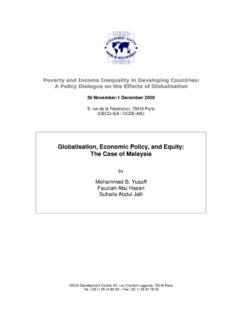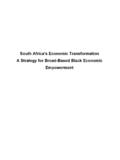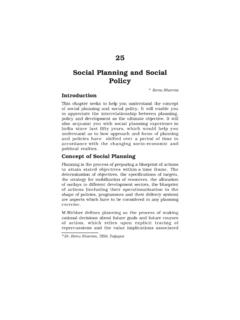Transcription of Growth-oriented Tax Policy Reform …
1 Tax Policy Reform and economic Growth OECD 201017 PART I Chapter 1 Growth-oriented Tax Policy Reform Growth-oriented TAX Policy Reform RECOMMENDATIONSTAX Policy Reform AND economic GROWTH OECD 201018 Tax systems are primarily aimed at financing public Tax systems arealso used to promote other objectives, such as equity, and to address social and economicconcerns. They need to be set up to minimise taxpayers compliance costs and government sadministrative cost, while also discouraging tax avoidance and evasion. But taxes also affectthe decisions of households to save, supply labour and invest in human capital, the decisionsof firms to produce, create jobs, invest and innovate, as well as the choice of savings channelsand assets by investors.
2 What matters for these decisions is not only the level of taxes butalso the way in which different tax instruments are designed and combined to generaterevenues (what this chapter will henceforth refer to as tax structures). The effects of tax levelsand tax structures on agents economic behaviour are likely to be reflected in overall livingstandards. Recognising this, over the past decades many OECD countries have undertakenstructural reforms in their tax systems. Most of the personal income tax reforms have triedto create a fiscal environment that encourages saving, investment, entrepreneurship andprovides increased work incentives. Likewise, most corporate tax reforms have been drivenby the desire to promote competition and avoid tax-induced distortions.
3 Almost all of thesetax reforms can be characterised as involving rate cuts and base broadening in order toimprove efficiency, while at the same time maintain tax report focuses on tax structures rather than levels, which is desirable becausecross-country differences in overall tax levels largely reflect societal choices as to theappropriate level of public spending, an issue that is beyond the scope of tax policyanalysis. Conversely, investigating how tax structures could best be designed to promoteeconomic growth is a key issue for tax Policy making. Yet, in practice, it is hard tocompletely separate the analysis of the overall tax burden from that of tax structure:countries that have a relatively high level of taxes may also have a tax structure that differsfrom that of other countries, and the response of the economy to a change in the taxstructure varies across countries, depending on their tax level.
4 Even more importantly,fully disentangling the revenue raising function of the tax system from its other objectives, , environmental or public health matters is difficult. In order to make theassessment of the effects of the tax structure on economic performance manageable, theseobjectives are not dealt with in great detail in this study, except when there is a clear tradeoff between them and tax reforms aimed at raising GDP per capita. Nevertheless, the waysin which governments use the tax system to achieve these other objectives have beenextensively studied by the OECD (for instance, see OECD, 2005c, on equity and OECD, 2006d,on the environment).Most of the discussion on the link between changes in the tax structure and economicperformance focuses on the effects on GDP levels.
5 This report, however, recognises that inpractice it may be difficult to distinguish between effects on levels and growth , any Policy that raises the level of GDP will increase the growth rate of GDP becauseeffects on GDP levels take time. Also, transitional growth may be long-lasting, and so it hasnot proved possible to distinguish effects on long-run growth from transitional Growth-oriented TAX Policy Reform RECOMMENDATIONSTAX Policy Reform AND economic GROWTH OECD 201019effects, although some elements of the tax system are likely to have a bearing for long-rungrowth. For instance, it is possible that taxes that influence innovation activities andentrepreneurship may have persistent long-run growth effects, while taxes that influenceinvestment also can have persistent effects on growth but these will fade out in the long-run.
6 In contrast, taxes affecting labour supply will mainly influence GDP levels. In thisspirit, this report looks at consequences of taxes for both GDP per capita levels and theirtransitional growth rates, with a large part of the empirical analysis (see Annex B) devotedto assessing the effects of different forms of personal and corporate income taxation ontotal factor productivity open economies the design of a national tax system will need to consider the designof tax systems in other countries, since countries are increasingly using their tax systemsto improve their ability to compete in global markets. Globalisation may also increasethe opportunities for tax avoidance and evasion especially as concerns mobile capitalincome tax bases.
7 Therefore, the mobility of the tax base plays some part in the designof tax reforms at the national level, and increased international tax Policy co-operationamong countries may allow for efficiency gains in some areas (for a discussion on thissee Box ).However, there are important issues that are addressed only cursorily. First, optimaltaxation, or how to minimise the excess burden of taxation, is an important topic that islargely outside the scope of this report, although some references are made to the maininsights provided by research in this area. Likewise, tax incidence, or who bears the burdenof a tax, is not explicitly addressed in this work, except when it has implications for theway the tax structure affects the determinants of , the transition costs of tax Reform are not considered in the empirical include not only the costs to the public administration but also the costs tobusinesses in adapting to Policy changes.
8 In some circumstances, it might also include thecosts of grandfathering some of the old tax provisions (or some other form ofcompensation) if taxpayers have made substantial investments based on the expectationthat these provisions would be maintained. The existence of these costs implies that taxreform will only be attractive if it can be expected to produce offsetting gains in economicperformance. These issues will be discussed in Chapter 3 of this this background, this chapter summarizes the main findings of the OECD project on the effects of changes in tax structures on GDP per capita and its maindeterminants. This study was carried out jointly by the OECD s Economics Departmentand Centre for Tax Policy and Administration in 2008 (OECD, 2008).
9 This study, which isincluded as Annex B to this report, reviewed tax structures and general trends in taxes thatare particularly relevant for growth and investigated how the structure of the tax systemcan have an impact on GDP per capita through its components, labour utilisation andlabour productivity. The study also discussed the impact on performance of each of themain categories of taxes (consumption, property, personal and corporate taxation) anddrew some conclusions concerning efficient tax design in each of these areas. In the lightof this discussion, the report also sketched possible Reform avenues for moving towards anoverall tax structure that may enhance aggregate economic performance, conditional onthe specificities of each Growth-oriented TAX Policy Reform RECOMMENDATIONSTAX Policy Reform AND economic GROWTH OECD Broad Policy options for reforming the overall tax mixThe tax Policy changes that are most likely to increase growth in any particularcountry will depend on its starting point, in terms of both its current tax system and theareas (such as employment, investment or productivity growth) in which its currenteconomic performance is relatively poor.
10 The discussed reforms should be seen as smalltax changes rather than suggesting that shifting the revenue base entirely to one particulartax instrument provides more of a growth bonus since it is probable that there arediminishing growth returns to adjusting analysis in this report suggests some general Policy options that could beconsidered. The reviewed evidence and the empirical work suggests a tax and growthBox role of GlobalisationGlobalisation the increased openness of economies to trade and investment combinedwith reduced transport costs and improve communications has several effects that needto be taken into account in formulating tax Policy :lTaxes can affect the costs of producing goods and services, and so change the relativeinternational competitiveness of some sectors, prompting structural and cross-border shopping mean that even VAT and sales taxes, which do notnormally apply to exports, can influence the demand of foreign residents fordomestically produced goods and income taxes can influence workers, particularly those who are highly paid, inthe choice of the country in which they income taxes can influence the choice of location of factories and offices.

















